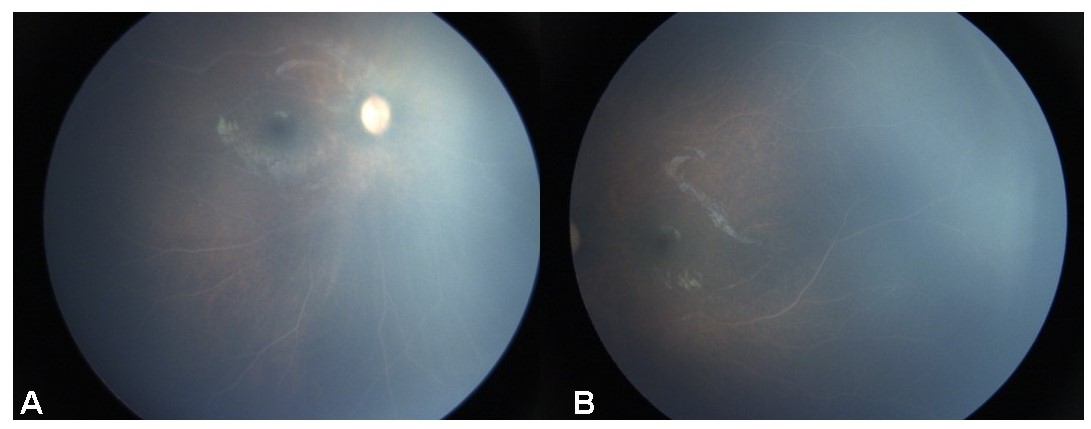[1]
Zahavi A, Snir M, Kella YR. Lipemia retinalis: case report and review of the literature. Journal of AAPOS : the official publication of the American Association for Pediatric Ophthalmology and Strabismus. 2013 Feb:17(1):110-1. doi: 10.1016/j.jaapos.2012.10.010. Epub 2013 Jan 18
[PubMed PMID: 23337350]
Level 3 (low-level) evidence
[3]
Vinger PF, Sachs BA. Ocular manifestations of hyperlipoproteinemia. American journal of ophthalmology. 1970 Oct:70(4):563-73
[PubMed PMID: 5505473]
[4]
Rayner S, Lee N, Leslie D, Thompson G. Lipaemia retinalis: a question of chylomicrons? Eye (London, England). 1996:10 ( Pt 5)():603-8
[PubMed PMID: 8977790]
[6]
Uysal E, Acar YA, Gökmen E, Kutur A, Doğan H. Hypertriglyceridemia induced pancreatitis (chylomicronemia syndrome) treated with supportive care. Case reports in critical care. 2014:2014():767831. doi: 10.1155/2014/767831. Epub 2014 Nov 23
[PubMed PMID: 25506434]
Level 3 (low-level) evidence
[7]
Brunzell JD, Bierman EL. Chylomicronemia syndrome. Interaction of genetic and acquired hypertriglyceridemia. The Medical clinics of North America. 1982 Mar:66(2):455-68
[PubMed PMID: 7040847]
[8]
Gehrisch S. Common mutations of the lipoprotein lipase gene and their clinical significance. Current atherosclerosis reports. 1999 Jul:1(1):70-8
[PubMed PMID: 11122694]
[9]
Leaf DA. Chylomicronemia and the chylomicronemia syndrome: a practical approach to management. The American journal of medicine. 2008 Jan:121(1):10-2. doi: 10.1016/j.amjmed.2007.10.004. Epub
[PubMed PMID: 18187065]
[10]
Cypel M, Manzano R, Dos Reis FA, Ishida N, Ayhara T. Lipemia retinalis in a 35-day-old infant with hyperlipoproteinemia: case report. Arquivos brasileiros de oftalmologia. 2008 Mar-Apr:71(2):254-6
[PubMed PMID: 18516428]
Level 3 (low-level) evidence
[11]
Sriram CS, Gulati S, Chopra V, Vashist S, Menon PS. Familial combined hyperlipidemia in a North Indian kindred. Indian journal of pediatrics. 2005 Nov:72(11):987-9
[PubMed PMID: 16391457]
[12]
Christian JB, Bourgeois N, Snipes R, Lowe KA. Prevalence of severe (500 to 2,000 mg/dl) hypertriglyceridemia in United States adults. The American journal of cardiology. 2011 Mar 15:107(6):891-7. doi: 10.1016/j.amjcard.2010.11.008. Epub 2011 Jan 19
[PubMed PMID: 21247544]
[13]
Horton M, Thompson K. Lipemia retinalis preceding acute pancreatitis. Optometry (St. Louis, Mo.). 2011 Aug:82(8):475-80. doi: 10.1016/j.optm.2011.01.011. Epub 2011 May 12
[PubMed PMID: 21570360]
[14]
Nagra PK, Ho AC, Dugan JD Jr. Lipemia retinalis associated with branch retinal vein occlusion. American journal of ophthalmology. 2003 Apr:135(4):539-42
[PubMed PMID: 12654375]
[15]
Özturk BT, Bozkurt B, Meşen A, Gonul S, İpekci SH. Spectral-Domain Optical Coherence Tomography Findings in Lipemia Retinalis. Ophthalmic surgery, lasers & imaging retina. 2016 Jun 1:47(6):589-92. doi: 10.3928/23258160-20160601-13. Epub
[PubMed PMID: 27327291]
[16]
Jain A, Mochi TB, Braganza SD, Agrawal S, Shetty BK, Pachiyappan B. Lipemia retinalis in an infant treated for retinopathy of prematurity. Journal of AAPOS : the official publication of the American Association for Pediatric Ophthalmology and Strabismus. 2017 Jun:21(3):254-257. doi: 10.1016/j.jaapos.2017.05.021. Epub 2017 May 27
[PubMed PMID: 28558973]
[17]
Shinkre ND, Usgaonkar UPS. Lipemia retinalis in a 27 day old neonate: A case report. Indian journal of ophthalmology. 2019 Jun:67(6):954-957. doi: 10.4103/ijo.IJO_1310_18. Epub
[PubMed PMID: 31124530]
Level 3 (low-level) evidence
[18]
Samanta R, Katoch D. Lipemia retinalis in an infant. Indian journal of ophthalmology. 2019 Jun:67(6):953. doi: 10.4103/ijo.IJO_225_19. Epub
[PubMed PMID: 31124529]
[19]
Parker F, Bagdade JD, Odland GF, Bierman EL. Evidence for the chylomicron origin of lipids accumulating in diabetic eruptive xanthomas: a correlative lipid biochemical, histochemical, and electron microscopic study. The Journal of clinical investigation. 1970 Dec:49(12):2172-87
[PubMed PMID: 5480845]
[20]
Gopal L, Sunder KS, Rao SK, Soni M, Sharma S, Ramakrishnan S. Hyperlipidemia in a poorly controlled diabetic presenting with lipemic aqueous and lipemia retinalis. Retina (Philadelphia, Pa.). 2004 Apr:24(2):312-5
[PubMed PMID: 15097900]
[21]
Wilson WS, Lee JH. Letter: Retinal xanthoma. Lancet (London, England). 1974 Jan 5:1(7845):34
[PubMed PMID: 4129022]
Level 3 (low-level) evidence
[22]
Jain S, Goyal A, Kumar V. Lipaemia retinalis in familial chylomicronaemia syndrome. Lancet (London, England). 2018 Aug 25:392(10148):e7. doi: 10.1016/S0140-6736(18)31796-3. Epub
[PubMed PMID: 30152345]
[23]
Fu V, Scanga HL, Medsinge A, Nischal KK. Improved visual function with dietary intervention in a child with lipemia retinalis. Journal of AAPOS : the official publication of the American Association for Pediatric Ophthalmology and Strabismus. 2014 Oct:18(5):488-90. doi: 10.1016/j.jaapos.2014.05.004. Epub 2014 Oct 21
[PubMed PMID: 25439305]
[24]
Yin HY, Warman R, Suh EH, Cheng AM. Exceptionally elevated triglyceride in severe lipemia retinalis. International medical case reports journal. 2016:9():333-336
[PubMed PMID: 27799830]
Level 3 (low-level) evidence
[25]
Stalenhoef AF, de Graaf J, Wittekoek ME, Bredie SJ, Demacker PN, Kastelein JJ. The effect of concentrated n-3 fatty acids versus gemfibrozil on plasma lipoproteins, low density lipoprotein heterogeneity and oxidizability in patients with hypertriglyceridemia. Atherosclerosis. 2000 Nov:153(1):129-38
[PubMed PMID: 11058707]
[26]
Chapman MJ. Fibrates in 2003: therapeutic action in atherogenic dyslipidaemia and future perspectives. Atherosclerosis. 2003 Nov:171(1):1-13
[PubMed PMID: 14642400]
Level 3 (low-level) evidence
[27]
Harris WS, Pottala JV, Thiselton DL, A Varvel S, Baedke AM, Dayspring TD, Warnick GR, McConnell JP. Does APOE genotype modify the relations between serum lipid and erythrocyte omega-3 fatty acid levels? Journal of cardiovascular translational research. 2014 Jul:7(5):526-32. doi: 10.1007/s12265-014-9554-8. Epub 2014 Mar 5
[PubMed PMID: 24595593]
[28]
McKenney J. New perspectives on the use of niacin in the treatment of lipid disorders. Archives of internal medicine. 2004 Apr 12:164(7):697-705
[PubMed PMID: 15078639]
Level 3 (low-level) evidence
[29]
Capitena CE, Wagoner HJ, Ruzas CM, Bennett TD, Baker PR 2nd, Jung JL, Weisfeld-Adams JD. Rapid resolution of infantile lipemia retinalis following exchange transfusion. Journal of inherited metabolic disease. 2016 Nov:39(6):889-890
[PubMed PMID: 27518769]
[30]
Schaap-Fogler M, Schurr D, Schaap T, Leitersdorf E, Rund D. Long-term plasma exchange for severe refractory hypertriglyceridemia: a decade of experience demonstrates safety and efficacy. Journal of clinical apheresis. 2009:24(6):254-8. doi: 10.1002/jca.20224. Epub
[PubMed PMID: 19927362]
[31]
Patel DV, Snead MP, Satchi K. Retinal arteriolar calcification in a patient with chronic renal failure. The British journal of ophthalmology. 2002 Sep:86(9):1063
[PubMed PMID: 12185140]

